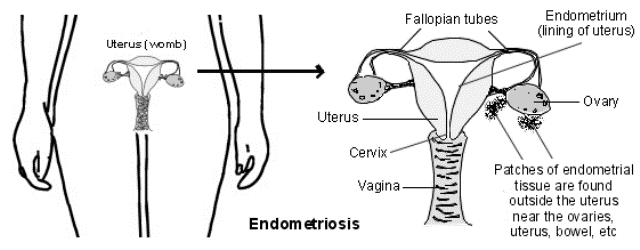Endometriosis is a condition where endometrial tissue is found outside the uterus. It is ‘trapped’ in the pelvic area and lower tummy (abdomen) and, rarely, in other areas in the body.

Who gets endometriosis?
The exact number of women who develop endometriosis is not known. This is because many women have endometriosis without symptoms, or with mild symptoms, and are never diagnosed.
Investigations to diagnose endometriosis are only done if symptoms become troublesome and are not eased by initial treatments (see below). Estimates vary so that from about 1 in 10 to as many as 5 in 10 of all women develop some degree of endometriosis.
If symptoms develop they typically begin between the ages of 25-40. Sometimes symptoms begin in the teenage years. Endometriosis can affect any woman. However:
- Sometimes it runs in families. Therefore, endometriosis is more common in close blood relatives of affected women.
- Endometriosis is rare in women past the menopause, as to develop endometriosis you need oestrogen, the female hormone. Oestrogen levels fall after the menopause.
- The combined oral contraceptive pill (often called ‘the pill’) reduces the risk of developing endometriosis. This protective effect may persist for up to a year after stopping ‘the pill’.
What causes endometriosis?
There have been several theories over the years. One theory was that some cells from the womb (uterus) lining (the endometrium) get outside the uterus into the pelvic area. They get there by spilling backwards along the Fallopian tubes when you have a period.
Currently we do not know what causes endometriosis. Most experts agree that there are many responsible factors, possibly including genetic, immunological, and hormonal reasons.
Patches of endometriosis tend to be ‘sticky’ and may join organs to each other. The medical term for this is adhesions. For example, the bladder or bowel may ‘stick’ to the uterus. Large patches of endometriosis may form into cysts which bleed each month when you have a period. The cysts can fill with dark blood; this is known as ‘chocolate cysts’.
What are the symptoms of endometriosis?
Patches of endometriosis can vary in size from the size of a pinhead to large clumps. Many women with endometriosis have no symptoms. If symptoms develop they can vary, and include those listed below.
In general, the bigger the patches of endometriosis, the worse the symptoms. However, this is not always the case. Some women have large patches of endometriosis with no symptoms. Some women have just a few spots of endometriosis, but have bad symptoms.
- Painful periods. The pain typically begins a few days before the period and usually lasts the whole of the period. It is different to normal period pain which is usually not as severe, and doesn’t last as long.
- Painful sex. The pain is typically felt deep inside, and may last a few hours after sex.
- Pain in the lower tummy (abdomen) and pelvic area. Sometimes the pain is constant, but is usually worse on the days just before and during a period.
- Other menstrual symptoms may occur. For example, bleeding in between periods.
- Difficulty becoming pregnant (reduced fertility). This may be due to clumps of endometriosis blocking the passage of the egg from an ovary to the Fallopian tube. Sometimes, the reason for reduced fertility is not clear.Other symptoms include pain on passing poo (faeces), pain in the lower abdomen when you pass urine, and, rarely, blood in the urine or faeces. Very rarely, patches of endometriosis occur in other sites of the body. This can cause unusual pains in parts of the body that occur at the same time as period pains.
How is the diagnosis of endometriosis confirmed?
The symptoms caused by endometriosis can be caused by other conditions. Therefore, if any of the above symptoms become persistent then tests are usually advised to find the cause of the symptoms. Endometriosis is usually confirmed by a laparoscopy. This is a small operation that involves making a small cut, under anaesthetic, in the tummy (abdominal) wall below the tummy button (umbilicus). A thin telescope-like instrument (a laparoscope) is pushed through the skin to look inside. Patches of endometriosis can be seen by the doctor.
A small pilot research study published in 2009 (cited in ‘References’ at the end) showed that the diagnosis may be able to be confirmed by a new test. In the study, a small sample (biopsy) was taken from the inner lining of the womb (uterus) – the endometrium – of women with endometriosis. The sample was looked at in the laboratory for some specific ‘markers’ of endometriosis. The results were that, in most cases, this new test was able to confirm the presence of endometriosis. So, if these results are confirmed by further studies, it may mean that in the future the diagnosis can be confirmed without the need for a laparoscopy (which involves a small operation).
How does Endometriosis progress?
If endometriosis is left untreated, it becomes worse in about 4 in 10 cases. It gets better without treatment in about 3 in 10 cases. For the rest it stays about the same. Endometriosis is not a cancerous condition.
Complications sometimes occur in women with severe untreated endometriosis. For example, large patches of endometriosis can sometimes cause a blockage (obstruction) of the bowel or of the tube from the kidney to the bladder (the ureter).
Source: Patient.co.uk
Nigeria’s Fight Against Endometriosis
Nigeria has been active in the fight against and awareness of Endometriosis.
Dr. Abayomi Ajayi, an Obstetrics / Gynecology surgeon, an infertility specialist, and founder of the Nordica Fertility Centreis an endometriosis advocate and is the leader of Team Nigeria and has partnered with the Endometriosis Support Group of Nigeria (www.endometriosis-sgn.org). On January 30, 2014, Dr. Ajayi (below) held a successful fundraiser for the first Fight Like a Girl! Million Woman March for Endometriosis in Nigeria.
Endometriosis Support Group is at the forefront of internationally recognised peer reviewed and professional services, programmes and resources and is actively lobbying for better outcomes for the combined market and population involved with endometriosis, including the Nigerian Government.
If you or anyone you know is experiencing any of the conditions mentioned above, please see a doctor.








Leave a Reply